This article first appeared on The Tomkins Times on May 14th, 2014.
I don’t think it’s just his (Luis Suarez) responsibility… To get into Champions League you need 70 odd goals…. To get into the top four you certainly need to score in the higher 60s into the 70s…. We’ve got a 40 goal striker (Suarez) and we still have to get 30 goals from somewhere else….maybe do that little bit more on set-pieces…
Brendan Rodgers interview on 28th November 2012.
The 2013-14 season has seen Liverpool score a staggering 101 goals in the Premier League at a rate of 2.66 goals per game. This is quite a contrast to last season when Liverpool averaged 1.87 goals per game. While defending has been a concern all season, the attacking department has flourished and has been the main reason behind our surprise title challenge this season, considering our main aim was to get into Champions League. This article aims to analyse Liverpool’s attacking performance over the course of 2013-14 season. The progress throughout the season has been remarkable. Rodgers has made few changes this season depending on the opposition and also tested out few different systems and formations depending on the players available to him. His decision to play Steven Gerrard in a deeper role in the latter part of the season has proved to be a masterstroke.
Early season clean sheets:
Liverpool started the 2013-14 league campaign with three straight 1-0 wins over Stoke City, Aston Villa and Manchester United. All three goals were scored by Daniel Sturridge. With Luis Suarez suspended, Iago Aspas partnered Daniel Sturridge but his overall effect on these games was minimal. Liverpool scored all three goals in the first half of each game and were vulnerable in the second half. The playing style of Brendan Rodgers was quite evident in these opening games and if the previous season was about implementing his philosophy, this season was about end product.
Brendan Rodgers’ main enemy last season was inconsistency. Liverpool needed a solid start and the consistency had to be maintained over the course of the season. With Liverpool’s rival for the Champions league spot, Tottenham Hotspur, spending €121.875.000 (via TransferMarkt) in the summer transfer window, the good start to the season was even more critical.
Liverpool’s passing wasn’t a problem in the opening games but the lack of pace upfront was key. Aspas isn’t the quickest of forwards and filling the boots of Luis Suarez is tough.
Liverpool lacked natural width, with Sterling only making a few substitute appearances in the opening three games. The team as a whole couldn’t get into a rhythm and there were very few glimpses of team work in these games. Too many of the passes were spread out to the wings rather than being played centrally. If Sturridge dropped into midfield, no one was present up top to collect the pass, with Aspas moving wider on many occasions.
With Liverpool opting to build up from back, too much time was spent in our own half and there was less penetration into the opponent’s half.
Lucas was preferred in the defensive midfielder role, while Gerrard and Henderson anchored the midfield. Coutinho was preferred to play in the front 3 of the 4-3-3 rather than a more athletic Sterling.
This was the set-up when Liverpool opted to play out from the back. The two centre-backs would spread out while the two wing-backs would push higher up. Brendan Rodgers stressed the importance of playing out from the back on numerous occasions, since his philosophy revolved around this.
“When we have the football everybody’s a player. The difference with us is that when we have the ball we play with 11 men, other teams play with 10 and a goalkeeper.” (Rodgers 2012)
Mignolet, fresh from a solid season with Sunderland, saved a penalty in the opening game against Stoke City. The role of goalkeeper in Brendan Rodgers’ system is key as the build-up phase starts from him. Pepe Reina was perfect for this role but his poor form in his last two seasons at Anfield forced a loan move to Napoli. Mignolet needed time to settle into this system since his role at Sunderland was quite different. In Sunderland’s 2012-13 campaign, he made a total of 620 passes at an average of 16.32 per game. But the total number of successful passes was 261 at an average of 6.87 per game, with a pass completion rate of 42%. On the contrary, this season, he has completed 425 of his 613 passes at a rate of 69%. His involvement in the build up phase and playing out from the back is vital to Liverpool’s start to the season.
This particular move against Aston Villa had 36 passes, and lasted 1 minute and 35 seconds:
Building up from back and circulating the ball around the halfway line was part of Rodgers’ philosophy, but runners in the middle were absent. Iago Apsas (9) in this instance should have dropped into the middle to receive a pass but he instead stayed wide. Sterling wasn’t given much game time and Liverpool, on the whole, were still finding their rhythm in these opening fixtures.
The game against Notts County in the League Cup provided the opportunity to experiment with the new arrival Luis Alberto and also to play the likes of Wisdom and Ibe. Liverpool needed extra time to seal the victory, but there were a few signs of improvement in the team’s play. Sturridge’s first goal involved some clinical passing in Liverpool’s midfield between Allen, Gerrard and Alberto.
Sunderland and Crystal Palace:
Luis Suarez returned from his ban and started alongside Daniel Sturridge for the first time this season against Sunderland. Liverpool’s threat from quick penetration from their own half was evident, as it was in the following game against Crystal Palace. Liverpool looked sharper in their threat going forward. The game against the Black Cats also saw Liverpool ending their second half goal scoring ‘jinx’.
Playing a 4-3-3 system, Liverpool played two natural strikers for the first time this season. They weren’t just goalscorers, and the chemistry between them was evident from last season. The coordination between them, the off-the-ball movements and the awareness between them were much needed in the attack.
The move to field both the players in the same line up was key to Liverpool’s attack. The advantage of having two attacking forwards in the team meant either could drop deep to receive but still have a man in the attacking zone. So the chance of getting from the defensive to attacking phase is very high and also quick. A simple long pass would be able to turn defence into attack quickly. The constant movement between them would also disrupt the defensive organisation of the opponent and also the chances of utilising the opponent’s high defensive line. The constant rotation of position between Sturridge and Suarez was evident and later, Sterling joined them to form a formidable three-man partnership in attack.
Against Sunderland, Liverpool scored the first of their nine goals from counter attacks. Gaining possession from a corner, they were quick to move from the defensive to attacking phase. The movement of Henderson dragged one of the centre-backs wide, which created space for Suarez to move into and score.
Liverpool were clearly improving with each game and Brendan Rodgers decided to test a new system against Newcastle, West Brom and Arsenal. He replaced the 4-3-3 system with 5-3-2; having previously tested it a few times last season. Arsenal exposed the frailties in the Liverpool set-up, while Newcastle took a deserved point, after playing the entire second half with 10 men. West Brom couldn’t manage to produce a result. Nevertheless, Liverpool and Brendan Rodgers learnt the drawbacks in the 5-3-2. The Reds didn’t have the right personnel to play this formation. Against Arsenal in particular, Liverpool were outplayed in all departments. Arsenal’s players exploited the spaces left by the two Liverpool wing-backs.
Arsenal also had numerical superiority in the centre of the pitch. One factor was that Gerrard isn’t the quickest of movers and couldn’t cope with the movement of Cazorla, Ramsey and Rosicky. Henderson was still finding his form and Lucas didn’t have any significant impact on the game. Liverpool wanted to play both the strikers together, using the 5-3-2, but the link between midfield and attack was missing. The strikers would often be isolated with no connection to the midfield. Liverpool midfielders had to track the runs of the opposition full-backs and midfielders. This meant that the strikers were left to attack on their own and the wing-backs, who were supposed to help out in attack, were too cautious, with the threat of Cazorla, Ramsey, Ozil and Giroud present in the Liverpool half. When the Reds lost the ball in transition, they would end up in a 3v2 situation.
The 5-3-2 system was then dropped for the home game against Fulham and Liverpool won the game comprehensively. Rodgers’ side then faced Everton at Goodison Park, and were in control of the game until Allen was replaced by Victor Moses. The away side dominated the midfield battle but the arrival of Moses meant that Everton had the chance to attack the space left by Allen in midfield.
Everton then took control of the game and created a large number of chances.
The two home games against Norwich will be remembered for the brilliance of Luis Suarez but a Steven Gerrard injury during the game against West Ham meant that Liverpool would face a different kind of challenge in their upcoming fixtures.
The Absence of Steven Gerrard:
With Gerrard absent for the games in December, Liverpool needed their other players to step up against the likes of Chelsea, Tottenham Hotspur and Manchester City.
Rodgers decided to use the 4-3-3 in these games with Henderson, Lucas and Allen forming the middle three. With Sturridge out injured, Sterling, Coutinho and Suarez formed the attacking trio. Joe Allen was approaching his Swansea form with good performances against Everton, Norwich and West Ham. Henderson’s work rate was much needed in these games and he started to form a solid partnership with Allen in midfield. Liverpool also started to show their ability to press the opposition and win back possession using the “6 seconds rule”.
Daniel Sturridge’s injury also gave a chance to Raheem Sterling, after his disappointing start to the season. Sterling needed some freedom to attack for his game to improve.
Henderson, though, started to prove his incredible value to the team in this period. He isn’t the most skilful of all players but he compensates for his weaknesses with pure hard work and determination to succeed at Liverpool. His late runs into the box and excellent passing were regularly evident during this period. His work rate also meant that he could be used as a pressing trigger.
This run in between two centre-backs allowed Luis Suarez to score against Tottenham Hotspur. His movement created space in front of Dawson, which Suarez ran into and was able to receive the pass. Joe Allen also does a similar job, when played in the team. As seen below against Norwich City recently.
Henderson pressing:
Since using zonal pressing, the role of Henderson has been critical. He would trigger the pressing and the players in their zones would press. Henderson was always supported by the other central midfielder (Coutinho or Allen).
The 5-0 victory against Tottenham Hotspur was one of the games of the season. The contribution from each player on the night was top class and the injury to Gerrard allowed Liverpool to use a different system with different players. It worked well against Tottenham and Manchester City.
“Every disadvantage has its advantage.” Johan Cruyff
Liverpool were unlucky to lose against Manchester City. A few defensive mistakes and an error by Simon Mignolet led to the defeat. The movement and coordination between Coutinho, Suarez and Sterling tested City to a large extent.
RAHEEM STERLING’S RESURGENCE
Sterling was now predominantly being used as an inside forward rather than as a traditional winger. He would stay closer to the centre-forward and would move towards the centre of the pitch rather than moving out wide. This is the opposite of how he played last season, when he was playing much wider, spending more time near the touch line. Brendan Rodgers changed him into a completely new player with a new role in the team. His runs behind the striker provided a new dimension to Liverpool’s attack.
His performance from last season has improved dramatically. This could be due to his change in position and change in his role in the team. This season, he didn’t have the greatest of starts, but his impact on the game changed once he started to play much closer to the centre of pitch behind the striker.
(Source: BBC Sport)
The diamond system (introduced later in the season) saw him playing behind the two strikers in the No 10 role. This meant that his pace could also be used in counter-attacks. Brendan Rodgers is turning him into more of an inside forward than a traditional winger, with his pace and movement utilised in the centre rather than on the wings. It’s more advantageous to counter through the centre than from the sides since the player in the middle with the ball (while countering) has options to pick on either side of him. He could change the direction of play to either side. But when the attack takes place on the wings, the attack is pretty much one dimensional. Time could be wasted if the ball has to be shifted from one side to the other, allowing time for the opponents to get back into their defensive shape.
Sterling has helped Liverpool to come out from the defensive phase in quick time and with speed, thereby creating a chance to counter. His decision-making in tight situations has improved though his crossing is his major weakness.
Diamond system:
Against Southampton, Liverpool started to play the diamond system. The first half performance on that day was poor, with Southampton creating six chances from the wings. Liverpool couldn’t settle into the new system and Brendan Rodgers soon introduced Sterling and shifted to a more suited 4-3-3.
The reason behind using this 4-3-1-2 could be the fact that this system is more direct than 4-3-3. The slow passing game would be replaced with a more direct game with the diamond. The option of playing two strikers more centrally would also help during counter attacks. The two strikers can stretch the opposition defence by spreading out or one of the strikers can drop deep while the other still remains in between the opposition centre-backs.
This is a simple passing situation where Liverpool are in a defensive phase with the opponent in possession. When the ball is won, a long pass option is available. The two strikers would spread out with Sterling (31) in between them. A simple knock down from Suarez (7) would start the counter-attack.
Sterling could use the option of playing into Sturridge (15) or take advantage of a 1v1 situation (if present) in the middle.
Raheem Sterling -a key change of role:
These kinds of attacks are associated with Arsenal under Arsene Wenger. His dynamic way of playing depends on early passes and explosive acceleration…win the ball and and score two seconds later. Dennis Bergkamp in his autobiography, said:
“The rhythm of the team’s famously deadly counter-attacking was rehearsed at London Colney. With static mannequins standing in for defenders, the team practised moving the ball from one end of the field to the other within seven or eight seconds.”
Liverpool used a similar approach in the latter half of this season. The trio of Sterling, Suarez and Sturridge were lethal in the transition from defence to attack. The movement of Sturridge and Suarez in between defenders would create space for Sterling to run into. Raheem Sterling played the role of No 10 with ease and with perfection.
The player position over the course of the season has changed dramatically. Against Manchester City (middle picture), Liverpool, using a 4-3-3, had played their forward a bit wider. This is similar to a traditional 4-3-3 system where the two wide forwards stay away from the centre forward. But in the diamond, the three attacking players would move closer towards each other, which creates space on either side of the pitch which will be used by the wing-backs for their runs.
The changes in the formation changed the role of Steven Gerrard. In a typical 4-3-3, his involvement in pressing would be minimal. But the diamond allowed him to move much freely from out of his position.
The game against Arsenal saw him play a deeper role in the 4-3-3. He would sit in between two centre-backs and would be less involved in the opposition half. But in the diamond, he would support the other two midfielders and also would go to press in the opposition half.
Gerrard (8) would move to either zones and help out in pressing. Since Liverpool used more of a Zonal pressing, the movement of Gerrard is important here. Both Allen (24) and Henderson (14) would not move away to other zones to press when not in transition. In a 4-3-3, Henderson (14) and Allen (24) would move to either Zone to press with Gerrard playing in between the midfield and defence.
The transition of Gerrard to this deeper role has been quite smooth and has restricted him to more of a sideways movement rather than forward, enabling him to spend more time on the ball and to pick out a long pass from a deeper position.
Are Liverpool a counter-attacking side?
This has been a long debate over the course of the season. Many pundits have labelled Liverpool as a counter-attacking side. Liverpool have scored nine goals from counter-attack, according to various statistical sites. To term Liverpool as a counter-attacking team is harsh considering the amount of goals that has been scored from a slow build-up. For example, Luis Suarez’s first goals against Cardiff had 24 passes for 73 seconds.
Liverpool scored quite a few goals this season that involved high passing and higher no of players. The term counter-attack is quite often misinterpreted. The traditional meaning of counter-attack is when a team scores after gaining possession in their own half and the opponent is disorganised when they attack. But Liverpool have scored quite a lot of goals after winning possession in the midfield with the opponent organised in defence.
Sterling’s goal against Arsenal at Anfield wasn’t termed as a goal from counter-attack since the Arsenal defence was organised and Liverpool weren’t in their defensive set-up.
When Henderson wins possession in the midfield, Arsenal are moving to a attacking phase. Liverpool gain possession and hit them on the break. Sterling runs into the space and scores.
CONCLUSION
Liverpool, like most teams, looks to nullify the opposition’s threat and produce a quick attack. But Liverpool often have looked to attack the opposition when they are in transition and tried to score. They have done it quite well this season, more than any other team.
The attacking displays Liverpool have produced this season has been a delight to look and the future seasons under Brendan Rodgers look very promising and exciting.










































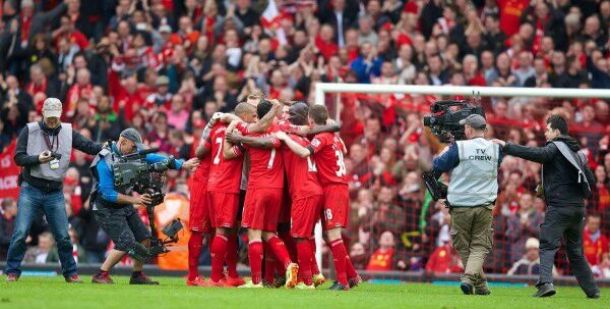
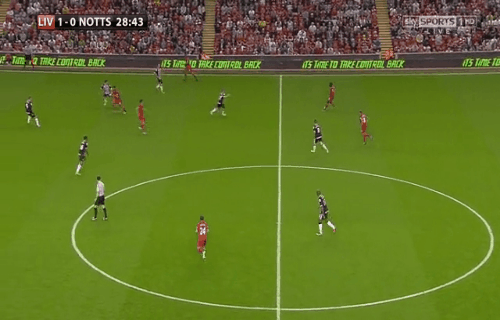 Sturridge goal - Notts County - Imgflip
Sturridge goal - Notts County - Imgflip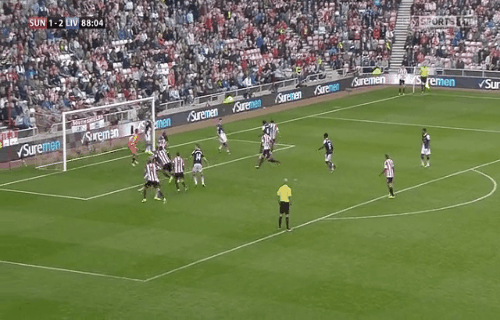 Suarez goal counter - Imgflip
Suarez goal counter - Imgflip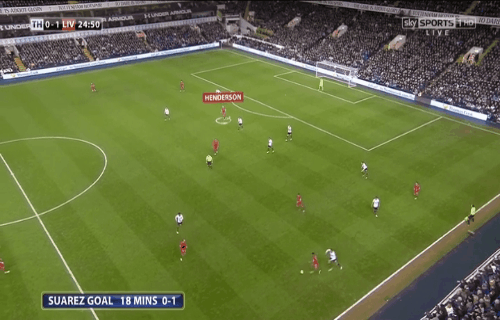 Henderson movement - Imgflip
Henderson movement - Imgflip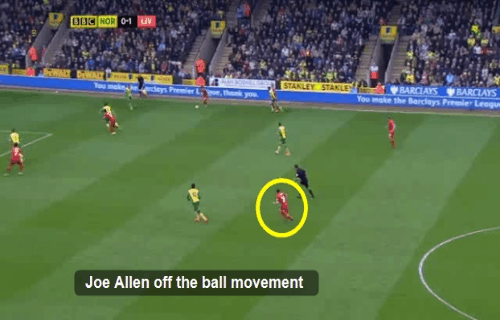 Allen movement - Imgflip
Allen movement - Imgflip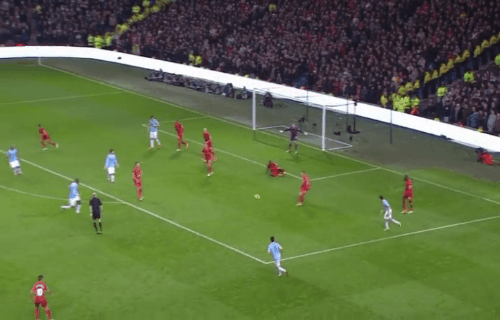 Movt - City - Imgflip
Movt - City - Imgflip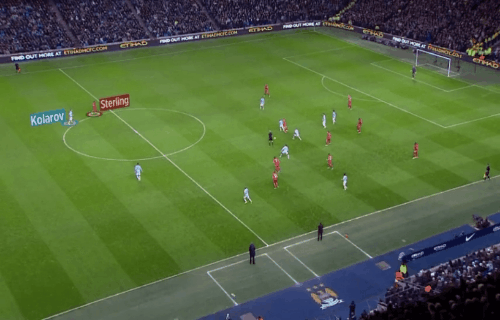 Sterling movement - Imgflip
Sterling movement - Imgflip